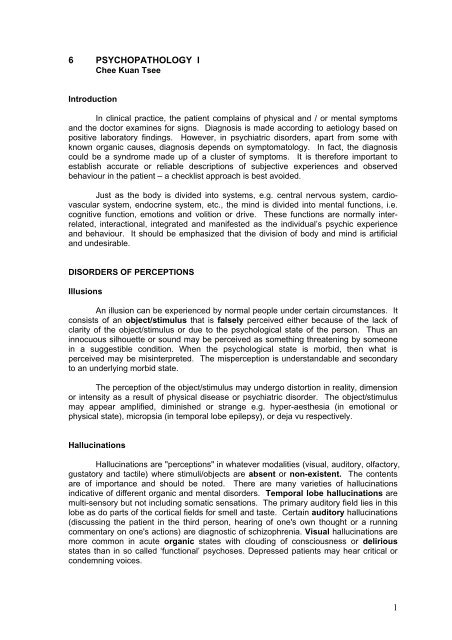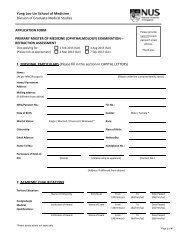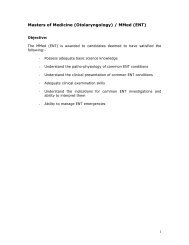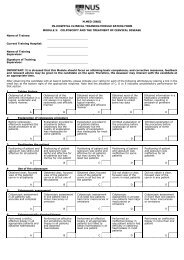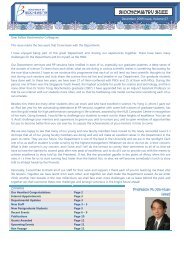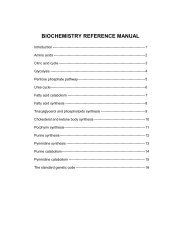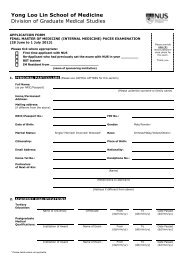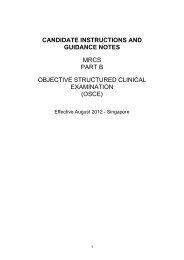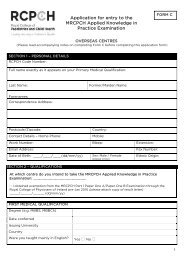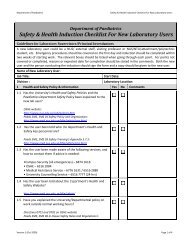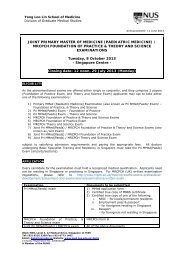6 PSYCHOPATHOLOGY I 1
6 PSYCHOPATHOLOGY I 1
6 PSYCHOPATHOLOGY I 1
Create successful ePaper yourself
Turn your PDF publications into a flip-book with our unique Google optimized e-Paper software.
6 <strong>PSYCHOPATHOLOGY</strong> IChee Kuan TseeIntroductionIn clinical practice, the patient complains of physical and / or mental symptomsand the doctor examines for signs. Diagnosis is made according to aetiology based onpositive laboratory findings. However, in psychiatric disorders, apart from some withknown organic causes, diagnosis depends on symptomatology. In fact, the diagnosiscould be a syndrome made up of a cluster of symptoms. It is therefore important toestablish accurate or reliable descriptions of subjective experiences and observedbehaviour in the patient – a checklist approach is best avoided.Just as the body is divided into systems, e.g. central nervous system, cardiovascularsystem, endocrine system, etc., the mind is divided into mental functions, i.e.cognitive function, emotions and volition or drive. These functions are normally interrelated,interactional, integrated and manifested as the individual’s psychic experienceand behaviour. It should be emphasized that the division of body and mind is artificialand undesirable.DISORDERS OF PERCEPTIONSIllusionsAn illusion can be experienced by normal people under certain circumstances. Itconsists of an object/stimulus that is falsely perceived either because of the lack ofclarity of the object/stimulus or due to the psychological state of the person. Thus aninnocuous silhouette or sound may be perceived as something threatening by someonein a suggestible condition. When the psychological state is morbid, then what isperceived may be misinterpreted. The misperception is understandable and secondaryto an underlying morbid state.The perception of the object/stimulus may undergo distortion in reality, dimensionor intensity as a result of physical disease or psychiatric disorder. The object/stimulusmay appear amplified, diminished or strange e.g. hyper-aesthesia (in emotional orphysical state), micropsia (in temporal lobe epilepsy), or deja vu respectively.HallucinationsHallucinations are "perceptions" in whatever modalities (visual, auditory, olfactory,gustatory and tactile) where stimuli/objects are absent or non-existent. The contentsare of importance and should be noted. There are many varieties of hallucinationsindicative of different organic and mental disorders. Temporal lobe hallucinations aremulti-sensory but not including somatic sensations. The primary auditory field lies in thislobe as do parts of the cortical fields for smell and taste. Certain auditory hallucinations(discussing the patient in the third person, hearing of one's own thought or a runningcommentary on one's actions) are diagnostic of schizophrenia. Visual hallucinations aremore common in acute organic states with clouding of consciousness or deliriousstates than in so called ‘functional’ psychoses. Depressed patients may hear critical orcondemning voices.1
Not all hallucinations are morbid in nature e.g. hypnogogic when falling to sleep,hypnopompic on waking up, and during sensory deprivation. Pseudo-hallucinationsare thought to be more mental images in internal subjective space and lacking substance.A simpler view is that the patient is aware of its non- reality.Delusional perception starts with a normal perception but with concomitantformation of a new abnormal idea of delusional nature. For instance, a patient seessomeone washing a car and instantaneously believes that gangsters are after him. It issometimes preceded by a delusional mood (feeling of something going on thatconcerns him). Together with the sudden development or intrusion of a delusional idea(out of the blue) they form the primary delusional experience characteristic ofschizophrenia.DISORDERS OF MEMORYThe formation of normal memory begins with attention to and normal perceptionof stimulus or subject material. Then there has to be proper registration, consolidationand retention of the perception and material for future recall when required. Any stage ofthe memory formation process may be affected by various reasons e.g. poor attentionand concentration, mood state, brain diseases, drugs, emotional conflict and normalforgetting. In addition, the left brain is more concerned with verbal memory and the rightbrain with visual-spatial memory.Impairment of memory in general indicates organic disorders e.g. delirium,dementia, brain disease, head injury and effect of drug/alcohol. However memoryfunction could be disturbed when the normal processes of registration, retention andretrieval are affected by various mental states. In situations of distraction, deficits ofattention and concentration and emotional conflicts such as anxiety, depression anddissociative disorders, memory disturbance is frequently complained of with fear of braindamage. Depending on the cause, amnesia may thus be subjective, reversible orpermanent.Memory could also be falsified in that what is remembered had in fact neverhappened or not exactly as it was. Deja vu, in which sense of familiarity in a new placewould be an example. In confabulation, fabricated or false answers of the past aregiven to questions asked because of amnesia. Delusional memory is the developmentof a delusion, side by side with a normal memory. It is similar in concept to delusionalperception of the primary delusional experience.DISORDERS OF THINKINGThinking is an association of ideas and is expressed in speech or writing forcommunication. However, in order to respond and communicate, the capacity tounderstand what is heard or read must be intact. In a psychiatric setting, disorders ofthinking cause breakdown in communication that is not due to organic lesion, intellectualfunctioning, language ability or barrier, or cultural difference.Frank Fish classifies disorders of thinking according to:1. Stream/Flow - whether rapid or slow, and its direction/goal e.g. flight of ideaswith chance association in mania; retardation of speech in depression2
2. Possession/Ownership - involuntary or alien in nature e.g. obsessionalruminations or thought insertion / withdrawal / broadcast as in schizophreniarespectively3. Content - what is expressed i.e. delusional ideas which may be persecutory,grandiose, nihilistic, erotic or jealousy4 Form - how words and ideas are associated or linked.Formal Thought DisordersThese refer particularly to that found in schizophrenia though they could alsooccur in coarse brain disease. If thought is ‘words forming ideas’ then examples rangingfrom the worst to the subtle type of thought disorder are as follows:Neologism - letters of the alphabet put together but not forming wordsWord salad - words thrown together but not forming sentencesDisjointed talk - no logical connection in sentencesDissociation of ideas -. paragraphs loosely linkedIn circumstantiality, the person does not come to the point directly. There ismuch beating around the bush and giving of a lot of details before finally answering thequestion. When the answer goes off the point completely it becomes tangential.DISORDERS OF MOODSWhat or how one feels and reacts depends on individual predisposition, which ispart of personality trait, and external factors in the environment. There is a range ofemotional experience and behaviour in sadness, joy, anger and fear that is consideredappropriate and normal.However, when the mood of depression (low spirit), elation (high spirit) orirritability is out of proportion in intensity and duration to what is understandable oracceptable and it dominates or overwhelms the individual, affecting his normalfunctioning, then a mood disorder exists. Primary mood disorder has secondaryeffects on other mental functions e.g. thinking, memory and behaviour. Sometimes amood disorder is not apparent unless the "emotional baseline" of the individual isknown. It could also be an acute on chronic situation i.e. the so called "doubledepression".In psychotic conditions, mood may be incongruous. Patients may laugh or crywithout appropriate reasons and feelings. Affective blunting which is characteristic ifnot diagnostic of schizophrenia shows a lack of sensitivity in feeling and has a qualityof indifference or callousness to it. Flattening of affect is a loss of expressivity offeeling such as masked facies in Parkinsonism or induced by neuroleptics. "La belleindifference" is typically described in conversion disorders in which the patient showsan inappropriate lack of concern about his disability.3
DISORDERS OF CONSCIOUSNESSConsciousness is the awareness of self and the environment. When theawareness is focused it is attention and when the attention is sustained it isconcentration. Normally, when an individual is in control of his mind, he is able to shifthis attention at will to concentrate on any immediate task at hand. Other objects orintrusions are kept out. In other words, at any point of time there would be a dominantconsciousness and possibly an hierarchy of subsidiary consciousness in the background.It is like multi-tasking on the computer with windows being opened or minimizedaccording to applications. However, when the mind is disturbed it loses control over whatthe dominant consciousness should be. Other covert mental processes become overtand manifest independently as various forms of psychopathology. Again it is like thecomputer with too many windows opened and fouls up. These “independent” mentalprocesses may dominate, interfere or co-exist with the “normal” mind. Some patients areable to recognize these abnormal mental processes in their mind and learn to suppressor overcome them.Under physiological condition, lowering of consciousness leads to sleep.Pathological clouding of consciousness would result in a comatose state. Confusion isclouding of consciousness with disorientation. It is obvious that other mental functionsi.e. perception, thinking and feeling are also affected. Hallucinations are present,thinking is disordered, the patient exhibits fear and restlessness as in delirium.Consciousness may also be restricted as in a dissociative or fugue state. Thiscondition has a sudden onset usually in response to acute overbearing stress. It isassociated with confusion about personal identity, inability to recall the past anddisorientation. This could result in a person wandering away and sometimes evenassuming a new identity.OTHER DISTURBANCES OF SELF-AWARENESSDepersonalizationThis is a feeling or sense of change in oneself whether emotionally orphysically with an unpleasant quality. It also includes derealization which refers to thesame phenomenon but of the environment. This sense of dissonant change in oneselfor the environment may be due to the dissociation between cognition and affect. Forinstance one patient says, "I know it is raining outside but I am unable to feel that it isso." Yet another who is panting away after exercise says "I am not able to feelbreathless."On the other hand, although the patient is unable to subjectively feel emotionsand yet his external emotional expressions or responses are observed to be quitenormal. Thus he may laugh heartily at a joke but states that he could not feel thehumour. In normal functioning we think, feel and behave in consonance.Identity and BoundaryThese are more psychotic phenomena in which the patient thinks he is nothimself but somebody else; his body is not his own; that he has no control over histhinking and feeling or there is mutual influence between himself and the environment.4
Passivity ExperienceIn schizophrenia there is complaint of being made to think, feel and act in certainmanner by some external force outside voluntary control. For example, a schizophrenicpatient may feel his thoughts are not his own but imposed on him by a computer.MOTOR DISORDERSGenerally, one's posture, movement, action or behaviour is intentional,purposeful and adaptive. But some postures, mannerisms and stereotyped movementsare symptomatic of mental disorders and non-adaptive. In catatonia there may be stiffor frozen posture or restless over-activity.Motor Disorders have been classified according to adaptive and non-adaptivemovements, motor speech, posture and abnormal patterns of behaviour.Thus there may be manneristic or stereotyped (rigid) speech and movements;echoing or repetitive imitating of what others say (echolalia) or do (echopraxia);perseveration of a response or activity and of posture (catalepsy).Catatonia may be exhibited at one extreme as excitement with marked agitation,impulsivity and aggressive behaviour and, at the other extreme, as rigidity with posturingand stereotyped behaviour or a stuporous state.References1. Fish F. Clinical Psychopathology. Bristol: Wright, 1974.2. Sims A. Symptoms of the mind. London: Bailliere Tindall, 1988.5


